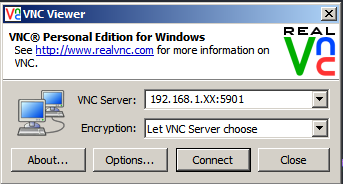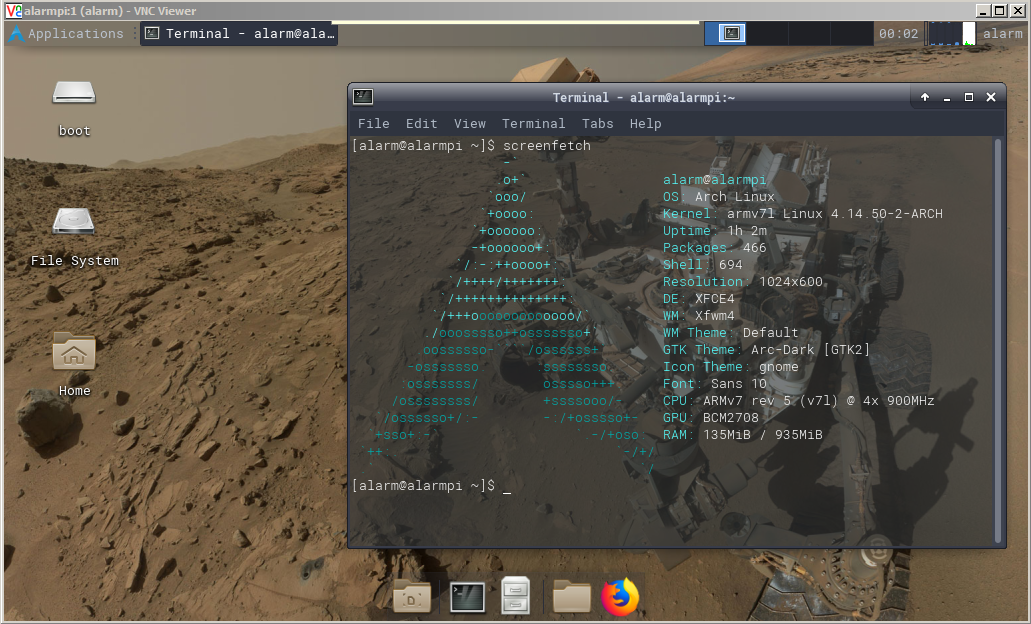Arch-ARM: xfce4 and x11vnc installation
Before install XFCE and TigerVNC, I recommend read both config post and put attention on Installation and Configuration sections. This installation is only thought VNC connection, without HDMI display.
XFCE installation:
For XFCE works correctly, we need install two stancies indispensably: xfce4 and xfce4-goodies.
[alarm@192.168.1.XX ~]: sudo pacman -S xfce4 xfce4-goodies
:: There are 16 members in group xfce4:
:: Repository extra
1) exo 2) garcon 3) gtk-xfce-engine 4) thunar 5) thunar-volman 6) tumbler 7) xfce4-appfinder 8) xfce4-panel
9) xfce4-power-manager 10) xfce4-session 11) xfce4-settings 12) xfce4-terminal 13) xfconf 14) xfdesktop
15) xfwm4 16) xfwm4-themes
Enter a selection (default=all): ''ENTER''
...
32) xfce4-wavelan-plugin 33) xfce4-weather-plugin 34) xfce4-xkb-plugin
:: Repository community
35) parole 36) ristretto 37) xfce4-whiskermenu-plugin
Enter a selection (default=all): ''ENTER''
...
:: Proceed with installation? [Y/n] yIMPORTANT: at this point you need have a monitor connected!
After install XFCE4, you can start XFCE by typing on terminal
[alarm@192.168.1.XX ~]: startxfce4TigerVNC installation:
[alarm@192.168.1.XX ~]: sudo pacman -S tigervnc
...
:: Proceed with installation? [Y/n] y
...
(3/4) Arming ConditionNeedsUpdate...
(4/4) Updating the desktop file MIME type cache...After installation, we need type on terminal: 'vncserver' That execute VNC for first time and you need put a new password fot VNC connection. Also, vncserver create some config files:
[alarm@192.168.1.XX ~]: vncserver
You will require a password to access your desktops.
Password:
Verify:
Would you like to enter a view-only password (y/n)? n
xauth: file /home/alarm/.Xauthority does not exist
New 'alarmpi:1 (alarm)' desktop is alarmpi:1
Creating default startup script /home/alarm/.vnc/xstartup
Creating default config /home/alarm/.vnc/config
Starting applications specified in /home/alarm/.vnc/xstartup
Log file is /home/alarm/.vnc/alarmpi:1.logNow, kill the server and edit your default startup script:
[alarm@192.168.1.XX ~]: vncserver -kill :1
Killing Xvnc process ID 0000XEdit ~/.vnc/xstartup and add XFCE by default desktop environment:
Remember make xstartup a execute file!
[alarm@192.168.1.XX ~]: cp ~/.vnc/xstartup ~/.vnc/xstartup.bckp
[alarm@192.168.1.XX ~]: nano ~/.vnc/xstartup
#!/bin/sh
unset SESSION_MANAGER
unset DBUS_SESSION_BUS_ADDRESS
exec startxfce4
[alarm@192.168.1.XX ~]: chmod u+x ~/.vnc/xstartupWhy create a copy of xstartup (xstartup.bckp)? Well, it's a good practice make a copy of any config file before modify it! So, if you need back to old config, only need rename that file!
Edit ~/.vnc/config Choose a screen size and other parameters if you need it:
[alarm@192.168.1.XX ~]: cp ~/.vnc/config ~/.vnc/config.bckp
[alarm@192.168.1.XX ~]: nano ~/.vnc/config
## Supported server options to pass to vncserver upon invocation can be listed
## in this file. See the following manpages for more: vncserver(1) Xvnc(1).
## Several common ones are shown below. Uncomment and modify to your liking.
##
securitytypes=vncauth
# desktop=sandbox
geometry=720x480
# localhost
# alwayssharedIf you want some doubts about video screen size, [check this post.]
After that, create a environment variable for a display:
[alarm@192.168.1.XX ~]: sudo nano /etc/profile
...
export DISPLAY=:0
[alarm@192.168.1.XX ~]: rebootVNCserver it's ready!
Remember: you need execute vncserver in terminal every time wants need it!
To execute VNCserver:
[alarm@192.168.1.XX ~]: vncserver
New 'alarmpi:1 (alarm)' desktop is alarmpi:1
Starting applications specified in /home/alarm/.vnc/xstartup
Log file is /home/alarm/.vnc/alarmpi:1.logHow to list all VNCserver?:
[alarm@192.168.1.XX ~]: vncserver -list
TigerVNC server sessions:
X DISPLAY # PROCESS ID
:1 329To kill a VNCserver:
[alarm@192.168.1.XX ~]: vncserver -kill :1
Killing Xvnc process ID 329How to connect Raspberry VNCserver to a VNC viewer?
First to all, we need know somethings. Every VNCserver by start with Raspberry generate a process with a display number. That's number it's interpreter by :X.
Yep! You can generate VNC server's unlimited if you want! Only limitation it's Raspberry resources!
Every VNCserver generate a port connection 590X. To connect the Raspberry, with need execute vncserver on Raspberry side, and connect via VNCviewer by the port assigned.
Example:
Raspberry side:
[alarm@192.168.1.XX ~]: vncserver
New 'alarmpi:1 (alarm)' desktop is alarmpi:1
Starting applications specified in /home/alarm/.vnc/xstartup
Log file is /home/alarm/.vnc/alarmpi:1.logVNCviewer side:

You can download VNCviewer from here!
The final result looks like that:

If you want know the packages installed on my Raspberry, you can check this gist!